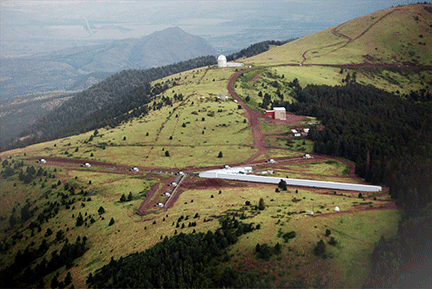MRO Interferometer Achieves Significant Milestone By Tracking Starlight
September 27, 2019
SOCORRO, N.M. – The Magdalena Ridge Observatory Interferometer reached a significant scientific milestone in the early hours of Friday, Sept. 27.
For the first time ever, scientists at the MROI tracked starlight going all the way from the telescope, through the beam relay, delay lines, beam compressor and on to BEASST.
“This is amazing because, in fact, although it seems that our work is routine, it isn’t,” said project director Dr. Ifan Payne. “It’s cutting edge technology and this has never been achieved in the world before using the advanced techniques we are using. So it’s very exciting.”
 The BEASST is the Back-End Active Stabilization of Shear and Tilt, which is the name
of the Shack-Hartmann stabilization system built specifically for the MRO-I. Eventually,
each telescope will have its own BEASST.
The BEASST is the Back-End Active Stabilization of Shear and Tilt, which is the name
of the Shack-Hartmann stabilization system built specifically for the MRO-I. Eventually,
each telescope will have its own BEASST.
(At right is an artists's rendering of how the Magdalena Ridge Observatory will look once completed, with the interferometer in the foreground and the 2.4-meter telescope in the background.)
New Mexico Tech scientists, along with collaborators from Cambridge University, had previously tested the system with artificial light. Dr. David Buscher is the Cambridge scientist who is currently on site in New Mexico, along with his graduate student James Luis. Buscher and Cambridge colleague Dr. Chris Haniff are the system architects for the MROI. Rob Ligon is the NMT project instrument scientist in charge of automated alignment system, beam compressors and fringe tracker.
“This is a combination of a lot of hard work,” Dr. Michelle Creech-Eakman said. “It’s not that any one of the components is difficult to build. The complexity is getting all those pieces to work together. They all have to talk to each other and we have to do that through software, so this is an important step.”
“Our next step is Performance Verification Milestone 3,” Creech-Eakman said. “We’ll try to measure sensitivity numbers to see how faint of targets we can go for and how long the beam stays stable.”
Payne said the software design has been a Herculean task.
“All of this is computer controlled and all the software is written in house by our software team, our subcontractors and a team at Cambridge,” he said. “So, it’s all original code and it’s extremely complex.”
The Magdalena Ridge Observatory was first conceived in the late 1990s. New Mexico Tech and Cambridge broke ground on the facility in 2004. In addition to the Interferometer, the mountaintop facility includes an optical 2.4-meter telescope, which became fully operational in 2008. The interferometer is currently on the final year of a funding contract with the U.S. Air Force Research Lab.
The Interferometer will take delivery of the second telescope enclosure in February 2020 and the second telescope in August 2020. They expect to fully incorporate the second telescope by the end of 2020, which will allow the instrument to produce “fringes,” using the proprietary fringe-tracker called ICoNN.
The MROI will be ultimately composed of ten 1.4-meter telescopes. The array will simulate a single dish telescope that can range in size from 7.8 to 340 meters in diameter.
"When completed the Magdalena Ridge Observatory Interferometer with arguably be the most powerful optical telescope in the world,” Payne said. “I am awed by the dedication and hard work of all the engineers and scientists working to make that dream come true."
The 10 telescopes will be optically linked together in order to make images of astronomical objects with unprecedented detail. The interferometer will have a resolution 100 times greater than the Hubble Space Telescope and will be able to make accurate images of complex astronomical objects many times faster than other existing interferometric arrays.
– NMT –